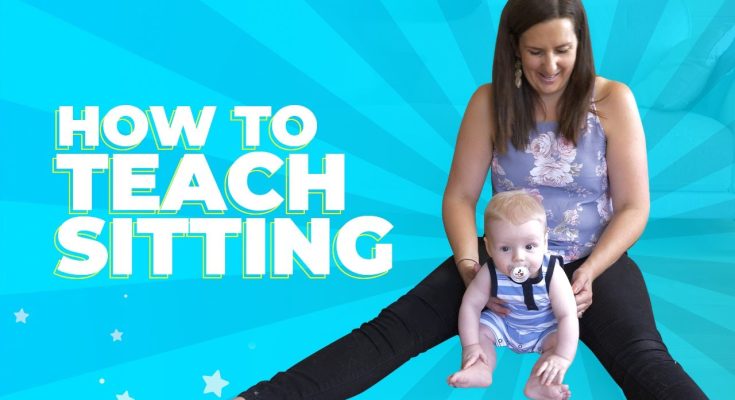One of the most exciting milestones in your baby’s development is learning to sit up independently. Sitting up is an essential skill that allows babies to explore their surroundings, play with toys, and interact more with their caregivers. But when do babies typically sit up? And how can you help your little one strengthen the muscles they need for this important milestone?
Most babies begin sitting with support around 4-5 months and can sit up independently between 6-8 months. However, every baby develops at their own pace. If your baby isn’t sitting up just yet, don’t worry! With a little practice and encouragement, they’ll get there. Here are five effective tips to help your baby sit up independently.
1. Encourage Tummy Time
Tummy time is one of the best exercises for strengthening your baby’s core, neck, and back muscles—all of which are essential for sitting up. Babies who get plenty of tummy time often develop stronger muscles and better coordination, making it easier for them to sit up when they’re ready.
How to Do It:
- Start tummy time from day one, even if it’s just for a few minutes at a time.
- Lay your baby on their tummy on a soft surface, such as a play mat or blanket.
- Use a rolled-up towel under their chest for extra support if needed.
- Place toys or a mirror in front of them to keep them engaged.
- Gradually increase tummy time as your baby gets stronger.
Why It Works:
Tummy time strengthens the neck, shoulders, arms, and core muscles, helping your baby build the strength needed to push themselves up and eventually sit.
2. Use a Supportive Sitting Position
Before your baby can sit independently, they need practice sitting with support. Providing proper support while they learn to balance helps them feel more secure and prevents falls.
How to Do It:
- Sit your baby on the floor and support them with your hands.
- Place them in a baby-safe chair or high chair for short periods (only if they have good head control).
- Use a nursing pillow or rolled-up towel around their waist for extra support while they practice sitting.
- Sit behind them with your legs open to create a soft, supportive barrier.
Why It Works:
Sitting with support allows babies to practice balancing and strengthening their muscles without the fear of falling over.
3. Encourage Reaching for Toys
Playing with toys while sitting encourages babies to use their core muscles and balance to stay upright. This helps them develop the strength and coordination needed to sit independently.
How to Do It:
- Sit your baby on the floor with a few toys placed slightly out of reach.
- Encourage them to lean forward and grab the toy while maintaining balance.
- Use toys that are colorful and engaging, such as soft blocks or rattles.
- Gradually move the toys around to encourage your baby to shift their weight and improve balance.
Why It Works:
Reaching for toys helps improve core strength, hand-eye coordination, and balance, all of which are necessary for sitting independently.
4. Provide Gentle Support and Guidance
Helping your baby transition from lying down to sitting up can teach them the mechanics of getting into a sitting position on their own.
How to Do It:
- Help your baby roll onto their side, then gently guide them into a sitting position.
- Hold their hands and let them pull themselves up from a reclined position.
- Encourage them to use their arms for support and balance.
- Once they are sitting, place your hands lightly on their back to prevent them from tipping over.
Why It Works:
This technique teaches your baby how to transition into a sitting position naturally and strengthens their core, back, and arm muscles.
5. Minimize Time in Baby Gear
While baby swings, bouncers, and activity centers are great for keeping babies entertained, too much time in these devices can delay muscle development needed for sitting.
How to Do It:
- Limit time in baby gear and encourage more floor play.
- Allow your baby to move freely on the floor to practice pushing up and balancing.
- Create a safe play area with soft blankets and cushions for them to explore movement.
Why It Works:
Babies develop strength and coordination through movement, so giving them more opportunities to play on the floor helps them develop the muscles needed to sit up.
When Do Babies Sit Up?
Every baby is different, but here’s a general timeline for sitting development:
- 0-3 months: Baby builds neck and core strength through tummy time.
- 4-5 months: Baby starts sitting with support (such as a caregiver’s hands or pillows).
- 6-7 months: Baby can sit for short periods without support but may still tip over.
- 8-9 months: Baby can sit independently and may begin transitioning between sitting and lying down.
If your baby isn’t sitting by 9 months, check with your pediatrician to rule out any developmental concerns.
Final Thoughts
Helping your baby learn to sit up is an exciting journey that requires patience, practice, and encouragement. By incorporating tummy time, supportive sitting, toy play, guided movement, and minimizing baby gear, you can gently guide your little one toward sitting up independently.
Remember, all babies develop at their own pace. Celebrate every small progress, and soon enough, your baby will be sitting up confidently, exploring their world with curiosity and joy!



